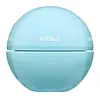What's inside
What's inside
 Key Ingredients
Key Ingredients

 Benefits
Benefits

 Concerns
Concerns

 Ingredients Side-by-side
Ingredients Side-by-side

Water
Skin ConditioningVitis Vinifera Seed Oil
EmollientGlycerin
HumectantMontmorillonite
AbsorbentLavandula Angustifolia Flower Water
Skin ConditioningKaolin
AbrasiveGlyceryl Stearate Citrate
EmollientSodium Stearoyl Glutamate
CleansingMelia Azadirachta Flower Extract
Skin ConditioningCoccinia Indica Fruit Extract
Skin ConditioningAzelaic Acid
BufferingCalendula Officinalis Flower Extract
MaskingArginine
MaskingMagnesium Aluminum Silicate
AbsorbentPolyglyceryl-3 Stearate
EmulsifyingHydrogenated Lecithin
EmulsifyingEthylhexylglycerin
Skin ConditioningTocopheryl Acetate
AntioxidantTocopherol
AntioxidantCitric Acid
BufferingSodium Benzoate
MaskingPotassium Sorbate
PreservativePhenoxyethanol
PreservativeWater, Vitis Vinifera Seed Oil, Glycerin, Montmorillonite, Lavandula Angustifolia Flower Water, Kaolin, Glyceryl Stearate Citrate, Sodium Stearoyl Glutamate, Melia Azadirachta Flower Extract, Coccinia Indica Fruit Extract, Azelaic Acid, Calendula Officinalis Flower Extract, Arginine, Magnesium Aluminum Silicate, Polyglyceryl-3 Stearate, Hydrogenated Lecithin, Ethylhexylglycerin, Tocopheryl Acetate, Tocopherol, Citric Acid, Sodium Benzoate, Potassium Sorbate, Phenoxyethanol
Water
Skin ConditioningCharcoal Powder
AbrasiveGlycerin
HumectantBentonite
AbsorbentKaolin
AbrasivePropanediol
SolventHamamelis Virginiana Extract
AntiseborrhoeicPersea Gratissima Oil
Skin ConditioningArgania Spinosa Kernel Oil
EmollientButyrospermum Parkii Butter
Skin ConditioningHelianthus Annuus Seed Oil
EmollientAloe Barbadensis Leaf Extract
EmollientRosmarinus Officinalis Leaf Extract
AntimicrobialCetearyl Alcohol
EmollientGlyceryl Stearate
EmollientAcrylates/C10-30 Alkyl Acrylate Crosspolymer
Emulsion StabilisingPentylene Glycol
Skin ConditioningCaprylyl Glycol
EmollientN-Prolyl Palmitoyl Tripeptide-56 Acetate
Skin ConditioningSodium PCA
HumectantWheat Amino Acids
Skin ConditioningPanthenol
Skin ConditioningSodium Hyaluronate
HumectantHydroxyproline
Skin ConditioningTitanium Dioxide
Cosmetic ColorantC12-15 Alkyl Benzoate
AntimicrobialPolyhydroxystearic Acid
EmulsifyingStearic Acid
CleansingAlumina
AbrasivePhenoxyethanol
PreservativeEthylhexylglycerin
Skin ConditioningDisodium EDTA
Water, Charcoal Powder, Glycerin, Bentonite, Kaolin, Propanediol, Hamamelis Virginiana Extract, Persea Gratissima Oil, Argania Spinosa Kernel Oil, Butyrospermum Parkii Butter, Helianthus Annuus Seed Oil, Aloe Barbadensis Leaf Extract, Rosmarinus Officinalis Leaf Extract, Cetearyl Alcohol, Glyceryl Stearate, Acrylates/C10-30 Alkyl Acrylate Crosspolymer, Pentylene Glycol, Caprylyl Glycol, N-Prolyl Palmitoyl Tripeptide-56 Acetate, Sodium PCA, Wheat Amino Acids, Panthenol, Sodium Hyaluronate, Hydroxyproline, Titanium Dioxide, C12-15 Alkyl Benzoate, Polyhydroxystearic Acid, Stearic Acid, Alumina, Phenoxyethanol, Ethylhexylglycerin, Disodium EDTA
 Reviews
Reviews

Ingredients Explained
These ingredients are found in both products.
Ingredients higher up in an ingredient list are typically present in a larger amount.
Ethylhexylglycerin (we can't pronounce this either) is commonly used as a preservative and skin softener. It is derived from glyceryl.
You might see Ethylhexylglycerin often paired with other preservatives such as phenoxyethanol. Ethylhexylglycerin has been found to increase the effectiveness of these other preservatives.
Glycerin is already naturally found in your skin. It helps moisturize and protect your skin.
A study from 2016 found glycerin to be more effective as a humectant than AHAs and hyaluronic acid.
As a humectant, it helps the skin stay hydrated by pulling moisture to your skin. The low molecular weight of glycerin allows it to pull moisture into the deeper layers of your skin.
Hydrated skin improves your skin barrier; Your skin barrier helps protect against irritants and bacteria.
Glycerin has also been found to have antimicrobial and antiviral properties. Due to these properties, glycerin is often used in wound and burn treatments.
In cosmetics, glycerin is usually derived from plants such as soybean or palm. However, it can also be sourced from animals, such as tallow or animal fat.
This ingredient is organic, colorless, odorless, and non-toxic.
Glycerin is the name for this ingredient in American English. British English uses Glycerol/Glycerine.
Learn more about GlycerinKaolin is a clay. It is used for oil control and to help minimize pores. Like other clays, kaolin has the ability to absorb excess sebum or oil. This can help clean out pores and mattify the skin.
Some types of kaolin may have exfoliating properties. When water is added to kaolin, it becomes a paste with small abrasive particles.
Most kaolin is a white color, but may be pink/orange/red depending on where it comes from.
The name 'kaolin' comes from a Chinese village named 'Gaoling'. Kaolin clay comes from rocks rich in kaolinite. Kaolinite, the mineral, has a silicate layered structure. Kaolinite is formed from chemical weathering of aluminum siilicate minerals.
Besides skincare, kaolin is commonly used to make glossy paper, in ceramics, toothpaste, and as medicine to soothe stomach issues.
Learn more about KaolinPhenoxyethanol is a preservative that has germicide, antimicrobial, and aromatic properties. Studies show that phenoxyethanol can prevent microbial growth. By itself, it has a scent that is similar to that of a rose.
It's often used in formulations along with Caprylyl Glycol to preserve the shelf life of products.
Water. It's the most common cosmetic ingredient of all. You'll usually see it at the top of ingredient lists, meaning that it makes up the largest part of the product.
So why is it so popular? Water most often acts as a solvent - this means that it helps dissolve other ingredients into the formulation.
You'll also recognize water as that liquid we all need to stay alive. If you see this, drink a glass of water. Stay hydrated!
Learn more about Water